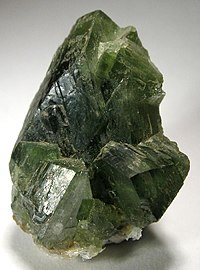Ludlamite
| Ludlamite | |
|---|---|
 | |
| General | |
| Category | Phosphate mineral |
| Formula (repeating unit) | (Fe,Mn,Mg)3(PO4)2·4H2O |
| IMA symbol | Lud[1] |
| Strunz classification | 8.CD.20 |
| Crystal system | Monoclinic |
| Crystal class | Prismatic (2/m) (same H-M symbol) |
| Space group | P21/a |
| Unit cell | a = 10.541(5), b = 4.646(4) c = 9.324(5) [Å]; β = 100.52°; Z = 2 |
| Identification | |
| Color | Apple-green to bright green |
| Crystal habit | Tabular crystals; massive, granular |
| Cleavage | Cleavage: perfect on {001}, indistinct on {100} |
| Mohs scale hardness | 3.5 |
| Luster | Vitreous, pearly on cleavage |
| Streak | Pale greenish white |
| Diaphaneity | Translucent |
| Specific gravity | 3.12–3.19 |
| Optical properties | Biaxial (+) |
| Refractive index | nα = 1.650 - 1.653 nβ = 1.669 - 1.675 nγ = 1.688 - 1.697 |
| Birefringence | δ = 0.038 - 0.044 |
| 2V angle | Measured: 82° |
| References | [2][3][4] |
Ludlamite is a rare phosphate mineral with chemical formula (Fe,Mn,Mg)3(PO4)2·4H2O. It was first described in 1877 for an occurrence in Wheal Jane mine in Cornwall, England and named for English mineralogist (1824–1880).
Occurrence[]
It occurs in granite pegmatites and as a hydrothermal alteration product of earlier phosphate bearing minerals in a reducing environment.[4] It occurs associated with whitlockite, vivianite, triploidite, triplite, triphylite, siderite, , and apatite.[2]
References[]
- ^ Warr, L.N. (2021). "IMA–CNMNC approved mineral symbols". Mineralogical Magazine. 85 (3): 291–320. Bibcode:2021MinM...85..291W. doi:10.1180/mgm.2021.43. S2CID 235729616.
- ^ a b Mindat.org
- ^ Webmineral.com
- ^ a b Handbook of Mineralogy
External links[]
![]() Media related to ludlamite at Wikimedia Commons
Media related to ludlamite at Wikimedia Commons
Categories:
- Phosphate mineral stubs
- Phosphate minerals
- Monoclinic minerals
- Minerals in space group 14